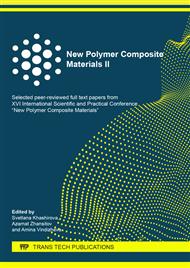p.152
p.158
p.163
p.169
p.175
p.182
p.190
p.196
p.202
New Plasticizers on the Based on 2,5-Furandicaboxylic Acid and 5,5-Oxy-Bis(methylene)bis-Furane-2-Caboxylic Acid Diesters
Abstract:
For the first time, the possibility of synthesis of 2,5-furandicarboxylic acid (FDCA) and 5,5-oxy-bis (methylene) bis-furane-2-caboxylic acid (OBFA) diesters and using them as plasticizers of various polymers have been studied. The most effective method for the synthesis of furan diesters is the direct esterification of FDCA or OBFA with the corresponding aliphatic diols С4-С10. Methods for the synthesis of these diesters with the yield of the target product from 45 to 85 % have been developed. The physical properties and plasticizing ability of the obtained 14 diesters were investigated. The plasticizing ability of the obtained diesters with respect to polyvinyl chloride (PVC), polystyrene (PS) and polymethyl methacrylate (PMMA) was studied. The plasticizing effect depends on the chain length of the aliphatic diol and the nature of the polymer. In general, the synthesized diesters have a stronger plasticizing effect on PS than on PVC and PMMA due to the higher stiffness of the PS chain. The plasticizing ability of the synthesized furan diesters that can be obtained from renewable plant materials is slightly inferior to industrial plasticizers based on phthalic and adipic acids, and are potentially able to replace standard plasticizers derived from hydrocarbons.
Info:
Periodical:
Pages:
175-181
Citation:
Online since:
October 2020
Authors:
Price:
Сopyright:
© 2020 Trans Tech Publications Ltd. All Rights Reserved
Share:
Citation:


